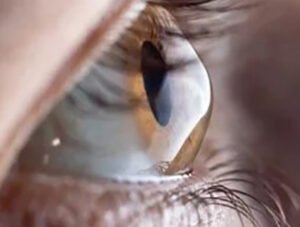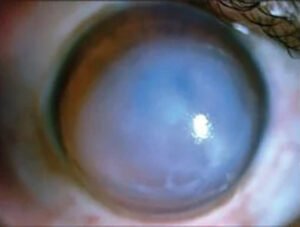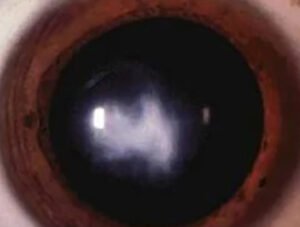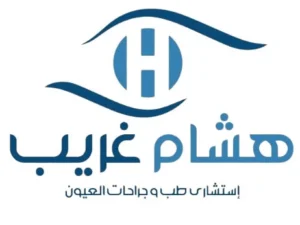Keratoconus is a condition that affects the shape and thickness of the cornea, causing it to change from its normal round shape to an irregular cone-like shape. This alteration negatively impacts how light is refracted within the eye, leading to blurred vision and difficulty seeing fine details — especially at night.
Although the condition often begins during adolescence, many patients do not notice it in its early stages. This makes early detection and timely intervention critically important.
What Are the Symptoms of Keratoconus?
- Blurry or hazy vision that does not improve with glasses.
- A rapid increase in the degree of myopia or astigmatism.
- Severe sensitivity to light (photophobia). Ask ChatGPT
- Frequent need to change prescription glasses.
- Difficulty driving at night or reading distant letters.

At Dr. Hesham Gharieb’s clinic, advanced diagnostic devices such as Topography and Pentacam are used to create an accurate map of the corneal surface and detect any early changes.
Stages of Keratoconus:
- Stage One (Mild): Usually treated with glasses or rigid contact lenses.
- Moderate Stage: May require corneal stabilization using ultraviolet light treatment (Cross-Linking).
- Advanced Stage: Requires more complex procedures such as intracorneal ring segment implantation or partial/full corneal transplantation.
Treatment Methods for Keratoconus
Corneal Cross-Linking (CXL)
A non-surgical procedure that uses ultraviolet (UV) light and riboflavin eye drops to strengthen the collagen fibers within the cornea, preventing further progression of the condition.
Intracorneal Ring Segments (Intacs)
Small rings are implanted inside the cornea to reshape it and improve vision. This is a simple procedure performed under local anesthesia, and it is effective in many moderate cases.
Corneal Transplantation
For very advanced cases where conservative treatments no longer work. The damaged cornea is partially or fully replaced with a healthy donor cornea.
Can Keratoconus Causes Blindness??
Unfortunately, keratoconus is a progressive disease that can lead to substantial corneal irregularity and scarring, resulting in vision loss. Additionally, in some cases, the cornea of the affected individual may swell rapidly due to a rupture of the inner lining of the cornea, allowing fluids to enter the cornea, which leads to a sudden decline in vision and the formation of scars in the cornea. This swelling typically subsides, but a scar may form that impacts vision.



Your needs are our top priority, and we use the most proven scientific methods in diagnosis and treatment.
We tailor your treatment plan and approach to achieve the desired outcome.
Our goal is to provide the best for your eyes and your vision.
making your decision to visit us easy and the right choice.
Call Us Now
Don’t hesitate to contact our friendly reception team for any general or medical inquiries — just give us a call.
Opening Hours
5th settlement (New Cairo)
Misr El-Gededa (Heliopolis)
Sun & Wed 3:00 – 5:00 PM
Dokki (Giza)
Sat & Mon 12:00 – 2:00 PM
